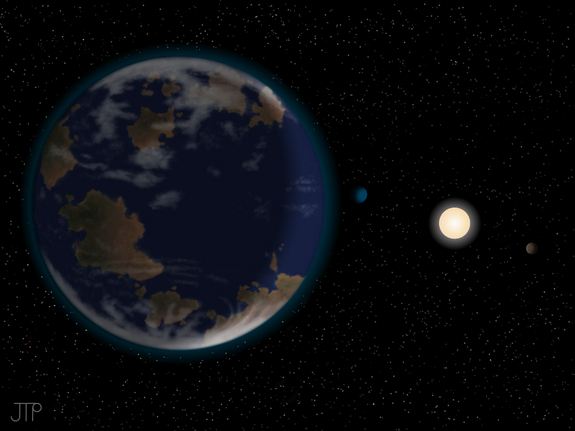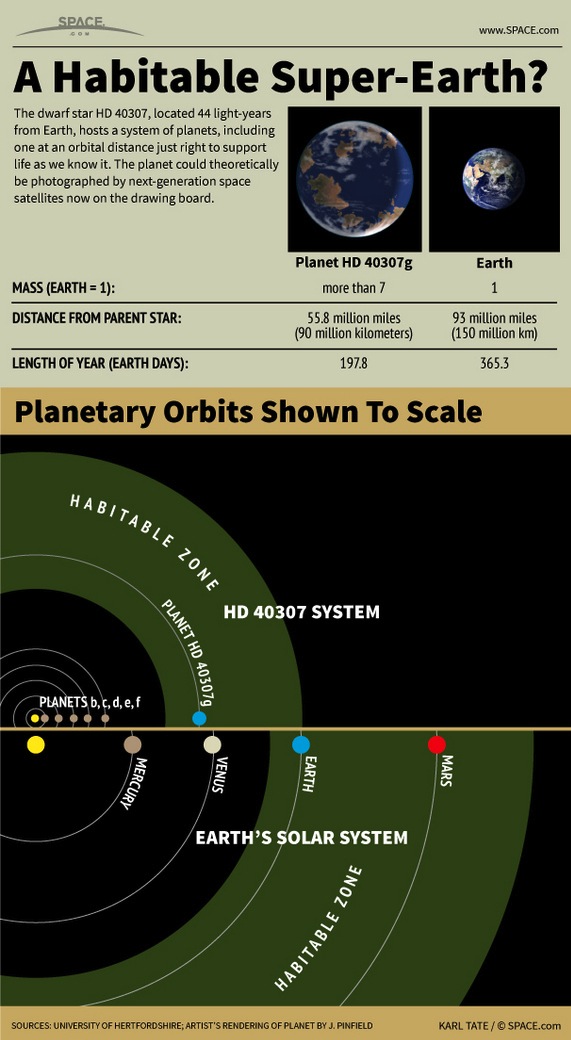Newly Discovered Earth-like Planet Could be Habitable
44 light years away, scientists have detected a planet that might be the right temperature to hold liquid water, a precondition for life
![]()

An artist’s rendering of the theorized Earth-like planet, potentially capable of containing liquid water. Image via University of Hertfordshire/J. Pinfield
The latest in a long string of recent exoplanet discoveries could be the most exciting one yet: A planet called HD 40307g, roughly 44 light years away, appears to be the most likely candidate to harbor life of any exoplanet we’ve discovered to date. Larger than Earth, but smaller than a gas giant, the planet seems to be in the “goldilocks” zone of its star system, the region with the right balance of heat and cold to potentially allow for liquid water.
To be clear, the discovery (described in a paper published yesterday in the journal Astronomy and Astrophysics), like nearly all other exoplanet discoveries, is indirect and theoretical. Rather than observing the planet with a telescope, a team of astronomers led by Mikko Tuomi of the UK’s University of Hertfordshire analyzed existing public data produced by the European Southern Observatory and realized it contained hints of something rather interesting. While scientists had previously looked at the star HD 40307 and found it was orbited by three planets, these astronomers used more sophisticated detection techniques to discover that it’s actually orbited by at least six.
One of these, HD 40307g, is the one that seems capable of potentially harboring life (exoplanets are named for their host star, along with lowercase letters starting with b and moving outwards—although some have argued that we really ought to be giving these distant planets more interesting names). The planet is roughly 7 times the mass of Earth, so is categorized as a Super-Earth, and orbits its star at a distance of 55.8 million miles, much closer than our distance from the sun, roughly 93 million miles.
This increased proximity is actually a good thing, though, because HD 40307 is slightly dimmer and colder than the sun, so the planet’s closer orbit lands it smack in the middle of its system’s habitable “goldilocks” zone, where liquid water can exist on a planet’s surface. This distance also means that the planet likely rotates on its axis, rather than having one side always facing inward, allowing for a day-and-night cycle that some scientists say increases the chance of life evolving. Additionally, it orbits its star once every 197.8 days, potentially even allowing for a seasonal climate like we have on Earth.
The astronomers relied upon the subtle effects of the planet’s gravity on its star to indirectly calculate its existence. ”The gravity of the star causes the planet to orbit it, but the planet has gravity too. As it circles the star, the star makes a littler circle too,” Phil Plait writes at Discovery‘s Bad Astronomy blog. “As the star makes its circle, half the time it’s approaching us and half the time it’s receding. This means its light is Doppler shifted, the same effect that makes a motorcycle engine drop in pitch as it passes you.” By precisely measuring a star’s Doppler shift, astronomers are able to indirectly tell if it is orbited by planets.
While this type of technique had previously been applied to HD 40307, Tuomi’s team used new methods of digitally canceling out visual background noise (such as the star’s solar flares and sunspots) to allow for the more sensitive detection of exoplanets that rotated out a little bit further. This led them to detect the presence of three more exoplanets in the system.
This indirect method allows us to determine the mass, distance and orbital period of each planet, but that’s about it. We don’t know the diameter of the planet, so it could have an Earth-like density with a much larger size, or it could have an Earth-like diameter with a super high density. The system is close enough to us, some speculate, that next generation telescopes might be able to see it directly.
Scientists have long sought to find planets in their systems’ “goldilocks zones” because of the longstanding belief that liquid water is necessary (but not sufficient) for the evolution of life as we know it. So far, most planets that we had found in habitable zones turned out to be gas giants, or have other characteristics that seemed to disqualify the presence of life. So even if HD 40307g turns out to not harbor life, the fact that we’ve finally found a seemingly habitable planet in such an area is a clue that Earth-like planets might not be as terribly rare as some have assumed.
/https://tf-cmsv2-smithsonianmag-media.s3.amazonaws.com/accounts/headshot/joseph-stromberg-240.jpg)

/https://tf-cmsv2-smithsonianmag-media.s3.amazonaws.com/accounts/headshot/joseph-stromberg-240.jpg)